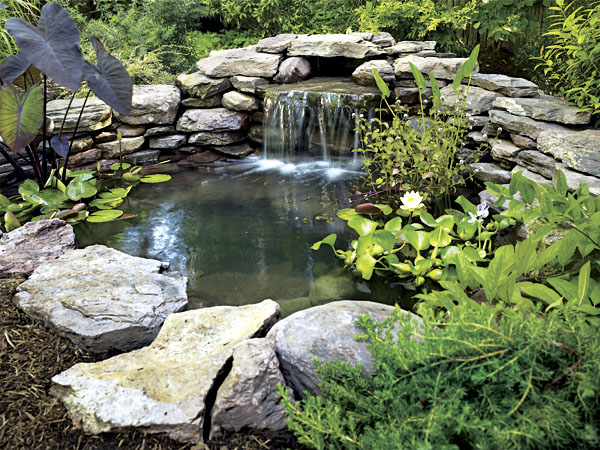Water features not only create a peaceful, relaxing outdoor space, and can also be a slice of nature for your viewing pleasure. Depending on what you choose to put in your pond, you can have a tranquil space or a wildlife-filled pocket of yard.

Planning
To set up your pond, you have to first carefully plan your pond. Taking pictures of your existing yard, creating sketches, and measuring are all important steps before you start to dig. Tracing your desired shape with a garden hose or spray paint will help you to keep your pond within the boundaries you have set up. If it is a small pond, a shovel and a wheelbarrow will be sufficient; if larger, renting a small excavator can greatly help you out with your digging. The top edges of your pond should be level, but the bottom doesn’t have to be. Remember to place shallow areas in shade, as this will help prevent algae growth.
Plants
When planning your pond, you must think about what plants to include. Visit a garden center to determine which plants will thrive in your area. If you want to include fish, consider which species will work well in your area, as well as what kind of pond ecosystem you want to facilitate.
Measure
Before filling, measure your pond correctly for the liner. Anchor liner with bricks or stones. Fill the bottom of your pond with rocks or sand; there are several options available at garden centers.
Filling
When filling your pond, fill very slowly. This is a key step in creating your pond; it will help the liner to settle and for the water to fill the pond completely. If you want to add fish to your pond and you are filling with tap water, allow water to settle first for chemicals such as chlorine to evaporate out of your pond.
Once your pond is dug and filled, you will want to create an entire space. You can add a patio or sitting space, gazebo, or just simple chairs. Filling the edges of your pond and area around the pond with landscaping will add to the beauty and ecosystem of your pond area. Choose plants wisely, considering what animals or pests your plants may attract or repel.
Maintenance
There will be a lot of maintenance and upkeep involved in your pond space, but none of it is too difficult or taxing. Many extension offices include tips on how to maintain your pond, especially if your pond is filled with fish. There are a few things you may want to consider:
- Pond Dyes: These products can stop algae growth by inhibiting sunlight from reaching the algae. One good product for this is called Crystal Blue Pond Dye.
- Pond cleaners: natural pond cleaners contain natural bacteria that can help with water clarity, reduce pond odor, and can clear up muck, dead vegetation and fish debris. They are completely safe for all wildlife, fish, plants, and recreation.
Mosquito control: mosquitoes breed in standing water, so your pond may become a breeding ground. You will not be able to eradicate these pests, but products like mosquito dunks can help to greatly reduce this in your pond space.
For more ideas on backyard ponds, please visit the Better Homes and Gardens pond page.

